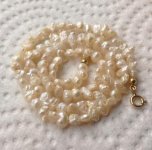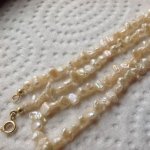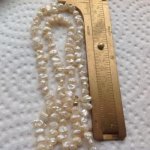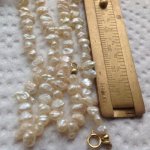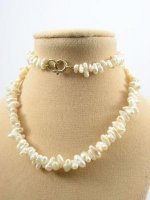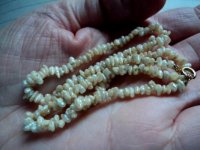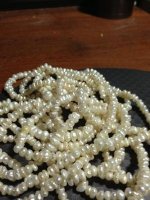mausketeer
Well-known member
- Joined
- Jul 7, 2008
- Messages
- 474
So......I received that strand from the UK that the seller said she believed were Scottish mussel pearls (she has an on-line antique and vintage jewelry shop, and looking at her listings, she DID seem knowledgeable about pearls in general. She had sold strands that she listed as old Akoyas, 1980's freshwaters, and Biwas - that looked like real Biwa so..... give this background whatever weight you will).
This strand is about 15". The pearls are about 2-3mm. Lovely lustre showing many colours. Lots of gold. Pink, green, even blue overtones. The clasp looks older. Only mark is 750 (for 18k gold) but it's very worn off. The clasp looks very solid, the ends that hold the thread aren't the "fold over" kind, they are solid. There is a bar inside to attach the thread to.
So, do we still feel these are "rice Krispy" pearls? Even with an old clasp? (clasp is older than 1970's-1980's I'm sure). Thoughts and opinions please! Thanks so much!
Jodie
This strand is about 15". The pearls are about 2-3mm. Lovely lustre showing many colours. Lots of gold. Pink, green, even blue overtones. The clasp looks older. Only mark is 750 (for 18k gold) but it's very worn off. The clasp looks very solid, the ends that hold the thread aren't the "fold over" kind, they are solid. There is a bar inside to attach the thread to.
So, do we still feel these are "rice Krispy" pearls? Even with an old clasp? (clasp is older than 1970's-1980's I'm sure). Thoughts and opinions please! Thanks so much!
Jodie

